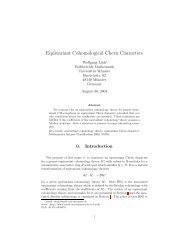Connes-Chern Character for Manifolds with Boundary and ETA ...
Connes-Chern Character for Manifolds with Boundary and ETA ...
Connes-Chern Character for Manifolds with Boundary and ETA ...
Create successful ePaper yourself
Turn your PDF publications into a flip-book with our unique Google optimized e-Paper software.
CONNES-CHERN CHARACTER AND <strong>ETA</strong> COCHAINS 31<br />
2.1.2. q = −1. Now let D be ungraded <strong>and</strong> put ˜D, α, E 1 as in Eqs. (2.12), (2.13), (2.14).<br />
Then by Proposition 2.4 we have<br />
b Ch k (D t )(a 0 , . . . , a k ) = √ π b Ch k (˜D t )(a 0 , . . . , a k ), (2.21)<br />
b /ch k (D t , Ḋt)(a 0 , . . . , a k ) = √ π b /ch k (˜D t , ˜D ˙<br />
t )(a 0 , . . . , a k ). (2.22)<br />
In the collar of the boundary, we write as usual D = Γ d + D dx ∂, <strong>and</strong> thus<br />
( ) ( )<br />
0 Γ d 0<br />
˜D =<br />
Γ 0 dx + D∂<br />
. (2.23)<br />
D ∂ 0<br />
} {{ } } {{ }<br />
=: Γ e =: D f ∂<br />
˜D ∂ is 2–graded <strong>with</strong> respect to<br />
( )<br />
0 1<br />
E 1 = , E<br />
−1 0 2 = −˜Γ =<br />
Note that<br />
For even k we have<br />
( )<br />
0 −Γ<br />
. (2.24)<br />
−Γ 0<br />
αE 1 E 2 = −Γ ⊗ I 2 , ˜D∂ = αE 1 (D ∂ ⊗ I 2 ). (2.25)<br />
(<br />
Str 2 a0 e −σ 0D g 2<br />
∂,t<br />
[˜D∂,t , a 1 ] · . . . · [˜D ∂,t , a k ]e −σ kD g 2)<br />
∂,t<br />
= 1<br />
4π Tr( αE 1 E 2 (αE 1 ) k( ) )<br />
a 0 e −σ 0D 2 ∂,t [D∂,t , a 1 ] · . . . · [D ∂,t , a k ]e −σ kD 2 ∂,t ⊗ I2 (2.26)<br />
= − 1<br />
2π Tr( )<br />
Γa 0 e −σ 0D 2 ∂,t [D∂,t , a 1 ] · . . . · [D ∂,t , a k ]e −σ kD 2 ∂,t .<br />
With respect to the grading given by −iΓ we can now write<br />
−1<br />
2π Tr( Γ·) = 1<br />
2πi Str 0 . (2.27)<br />
Together <strong>with</strong> (2.21) <strong>and</strong> (2.22) we have thus proved:<br />
Proposition 2.6. Let M be an odd dimensional compact manifold <strong>with</strong> boundary <strong>with</strong><br />
an exact b-metric <strong>and</strong> let D be an ungraded Dirac operator. Writing D in a collar of<br />
the boundary (in cylindrical coordinates) in the <strong>for</strong>m<br />
D =: Γ d<br />
dx + D ∂, (2.28)<br />
D ∂ is a graded Dirac type operator <strong>with</strong> respect to the grading operator −iΓ. Furthermore,<br />
we have<br />
b b Ch k−1 (D t ) + B b Ch k+1 (D t ) = 1<br />
2 √ πi Chk (D ∂ ) ◦ i ∗ , (2.29)<br />
d b Ch k (D t ) + b b /ch k−1 (D t ,<br />
dt<br />
Ḋt) + B b /ch k+1 (D t , Ḋt)<br />
= − 1<br />
2 √ πi /chk (D ∂ t , Ḋ∂ t ) ◦ i ∗ .<br />
(2.30)

















